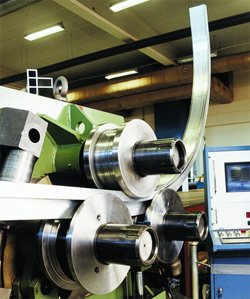Fabrication & Finishing
Bending
Imagine taking a single aluminum extrusion and adding multiple bends to create a 1-piece frame for the door of a Class 8 truck. Or forming a hoop for a bicycle wheel rim, or adding a gentle sweep to a structural element for office furniture or creating an arch for a new energy-efficient window for an historic building. With the right profile design, the right bending process, and the right experience, even more complex shapes can be bent — often simplifying component design and achieving distinctive aesthetics.
Bending needs to be addressed during the component design stage, as alloy selection and heat treatment must be considered. Also, the profile design and desired final geometry will influence the bending process employed and the consideration and management of spring back.

Typically, extruders offer several different bending processes, to meet a variety of final component requirements:
- Roller bending — like the illustration at the right — is used to bend extrusions to a large radius, and can roll a fully circular part
- Stretch, or rotary draw bending can be used to create more complex, multiple bend parts, via CNC control, with or without a mandrel
- Press or ram bending is best for simpler operations. Parts are shaped in a two part tool with a bending die pushing the profile against pressure dies.
Given the range of processes, it is recommended that you explore your bending requirements with the technical staff of an experienced extrusion bender early in the design process. Find an Extruder can help locate an extruder with the right fabrication experience.
Image: Sapa Extrusions
 -
-




 |
|